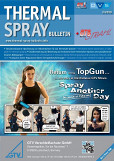Characterization and evaluation of emissionsduring thermal spraying under production-relevantconditions
Authors: Prof. Dr.-Ing. Kirsten Bobzin, Dipl.-Ing. Tim Königstein, Dr.-Ing. Wolfgang Wietheger, Prof. Dr. med. Thomas Kraus, Dr. rer. nat. Manfred Möller
Many industrial processes emit particle emissions which have an impact on humans and the environment. Particularly in thermal spraying, the fundamentals on the formation and effects of process-related emissions are limited. During the process the operator is outside the cabin and thus the area in which emissions are generated. Nevertheless, a process-related reduction particularly of ultrafine particles would be desirable to also ensure a safe environment for the operator when cleaning and conversion work in the cabin is necessary. Within the frame of the AiF research project “TS-Emissionen II”, initiated by the Association of Thermal Sprayers (GTS e. V.), formation mechanisms of ultrafine particles during thermal spraying were investigated in order to use these findings to minimize emissions. Within the scope of this investigation, especially the measurement setup as well as the characterization of the APS process with the feedstock materials WC-CoCr and NiCr are presented. The focus of these experiments concentrates in particular on the detection and characterization of ultrafine particle emissions. In addition, toxicological investigations are conducted in order to assess the potential risks of the resulting emissions.
Pages: 78 - 87










Order this article as a PDF for 8.00 Euro. Send us a short e-mail with your details.
An active subscription enables you to download articles or entire issues as PDF-files. If you already are a subscriber, please login. More information about the subscription








